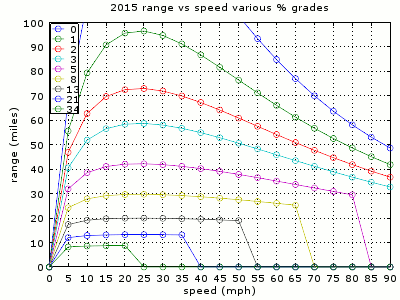I made a 61 mi trip recently, 30 mi each way, first descending 3400', then returning and climbing back up. Both legs were under the same conditions, light rain and slow highway speeds (ave: ~55mph).
I averaged 16.3 mi/kWh downhill and 2.9 mi/kWh returning along the same route uphill. The whole trip average was 5.0 mi/kWh, which is about the same as if the entire trip was on level ground (in light rain, slow highway speeds, occasional heating/venting).
Being able to regen on the downhill portion means EVs are very efficient at changing elevations. Just like ICE vehicles, they take lots of fuel or battery energy to climb a hill, but EVs using regen can "collect" energy back going downhill instead of wasting it in friction brakes.
Because my trip was out-and-back driven under similar conditions, I can estimate the gains or losses due to the elevation change alone.
Math follows:
Downhill energy used: 1.9 kWh
Uphill energy used: 10.4 kWh
Delta energy over one leg: (10.4-1.9)/2 = 4.25 kW or 1.25 kW per 1000 ft elevation
A longer way to calculate this:
Average mi/kWh: 61.3/(1.9+10.4) = 4.98 mi/kWh
One way: 30.65 mi / 4.98 mi/kWh = 6.15 kW
Delta energy over one leg: 6.15 - 1.9 = 4.25 kw or 1.25 kW per 1000 ft
Physics follows:
If you look at just the potential energy gain/loss, we can predict the same:
Potential Energy = mass * g * height
where:
Mass = 2866 + 200 + 170 = 3236 lbm -> 1468 kg
g = 9.807 m/s/s
height = 3,400 ft -> 1036 m
PE = 1468 kg * 9.807 m/s/s * 1036 m = 14,914,956 J or 14,914,956 Ws
Converting Joules to kWh by dividing by 3600 sec/hr and dividing by 1000 W per kW = 4.14 kWh
and 4.14 kWh / 3.4 kft = 1.22 kWh per 1000ft
So this is pretty damn close! Yeah physics!
I averaged 16.3 mi/kWh downhill and 2.9 mi/kWh returning along the same route uphill. The whole trip average was 5.0 mi/kWh, which is about the same as if the entire trip was on level ground (in light rain, slow highway speeds, occasional heating/venting).
Being able to regen on the downhill portion means EVs are very efficient at changing elevations. Just like ICE vehicles, they take lots of fuel or battery energy to climb a hill, but EVs using regen can "collect" energy back going downhill instead of wasting it in friction brakes.
Because my trip was out-and-back driven under similar conditions, I can estimate the gains or losses due to the elevation change alone.
Math follows:
Downhill energy used: 1.9 kWh
Uphill energy used: 10.4 kWh
Delta energy over one leg: (10.4-1.9)/2 = 4.25 kW or 1.25 kW per 1000 ft elevation
A longer way to calculate this:
Average mi/kWh: 61.3/(1.9+10.4) = 4.98 mi/kWh
One way: 30.65 mi / 4.98 mi/kWh = 6.15 kW
Delta energy over one leg: 6.15 - 1.9 = 4.25 kw or 1.25 kW per 1000 ft
Physics follows:
If you look at just the potential energy gain/loss, we can predict the same:
Potential Energy = mass * g * height
where:
Mass = 2866 + 200 + 170 = 3236 lbm -> 1468 kg
g = 9.807 m/s/s
height = 3,400 ft -> 1036 m
PE = 1468 kg * 9.807 m/s/s * 1036 m = 14,914,956 J or 14,914,956 Ws
Converting Joules to kWh by dividing by 3600 sec/hr and dividing by 1000 W per kW = 4.14 kWh
and 4.14 kWh / 3.4 kft = 1.22 kWh per 1000ft
So this is pretty damn close! Yeah physics!

